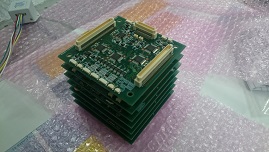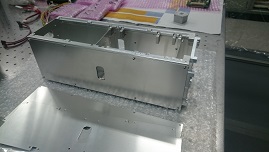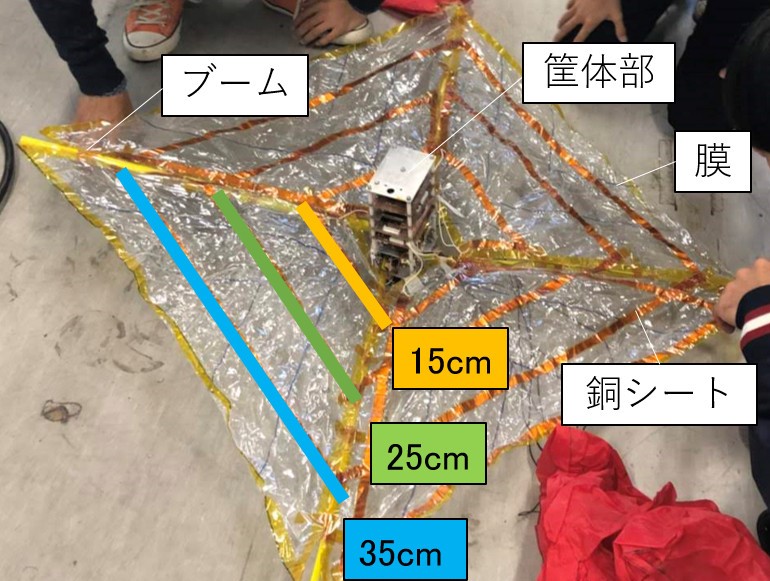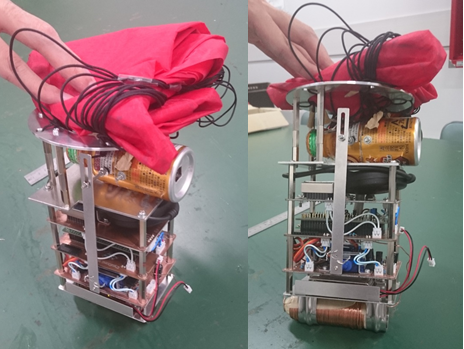Overview of our laboratory
Space systems that can be achieved only by small satellites.
To take advantage of small sized space systems, these systems should acquire unique abilities by focusing on phenomena which are more effective for smaller satellites. Additional advantages can be gained by the additional use of various resources and other things found in its orbital environment. Our research group recognizes that a smaller sized satellite is more affected by its environment. Additionally, it considers the use of these environments, to achieve higher performance with smaller system resources to be useful. Furthermore, space applications with these high performance bus systems are studied, by taking advantage of the unique abilities of these small spacecraft.
Research topics
Attitude orbit and control system by the use of space environment.
In our research, we continue to expand the abilities and applications of small spacecraft, while considering the space environments that more easily affect smaller sized spacecraft, specifically environmental outer magnetic fields and space plasma. We focus on attitude and orbit determination and control for small spacecraft to expand the abilities and applications. Except for attitude orbit control systems, our interest lies on C&DH, thermal, communication, space system designs, and their applications. We also try to find chances for in-orbit demonstrations for the benefit of proposing space systems.
CubeSat
In-orbit demonstrations for the benefit of proposing space systems.
In Inamori Laboratory, in order to prove the result of our researches in actual orbit, we are also developing actual small-sized satellite. Currently, we are developing NUcube1, a small-sized satellite whose mission is to demonstrate orbit alteration using rotation separation system that was proposed by our laboratory. In this system, by separating two satellites that was fixed together during high-speed rotation, one satellite will be accelerate while the other one will be decelerate and thus altering the orbit of these two satellites. We expect that this method can be used in space application such as for constellation formation alteration of satellites. NUcube1 is the combination of a 2U main satellite and a 1U sub satellite. In the main satellite magnetic torquers (MTQs), in the sub satellite permanent magnets are implemented. In this system, the satellites will be spins up using MTQ while maintain theirs combination using magnetic force between MTQs and magnets. Then, the separation will be done by changing MTQ output. This time, the MTQs core will be used as part of the satellite structure so that we can produce a large magnetic moment output from MTQ while maintaining the weight of the satellite. Our development are currently in BBM phase and we are continuing our development with the plan to launch on 2020 in mind.


CanSat
As a preliminary practice for actual satellite development, we develop a can-size imitation (Cansat) that contains basic functions of actual satellite. In 2018, in relation to one of our research topics “attitude control of space membrane using electromagnetic force”, we developed and launched a Cansat that has membrane’s deployment structure as well as a circuit that allows large electric current flow on top of the satellite’s membrane. The developed Cansat was launched at ARLISS, an annual event at Black Rock desert in Nevada State, America where many teams around the world gather together and launch their Cansat.


Publications
2018
Journal papers
J. Park, S. Matsuzawa, T. Inamori, I. Jeung, Nanosatellite constellation deployment using on-board magnetic torquer interaction with space plasma, Advances in space research, Article in press, 2018.X. Yaen, W. Xiande, T. Inamori, S. Zhen, S. Xinzhu, C. Hongtao, "Compensation of base disturbance using optimal trajectory planning of dual-manipulators in a space robot", Advances in space research, Vol. 63, Issue 3, pp. 1147-1160, 2019.
T. Inamori, S. Ikari, T. Ito, R. Kawashima, "Interplanetary magnetic attitude control based on an IMF observer in small Spacecraft", IEEE Transactions on Aerospace and Electronic Systems, article in press.
T. Ito, S. Ikari, R. Funase, S. Sakai, Y. Kawakatsu, A. Tomiki, T. Inamori, "Active use of solar radiation pressure for angular momentum control of the PROCYON micro-spacecraft", Acta Astronautica, Elsevier, Vol. 152, pp 299-309, 2018.
T. Kawai, T. Inamori, K. Hori, "Analytical Lorentz force model between one-dimensional linear currents in arbitrary relative positions and directions", IEEE Transactions on Magnetics, vol. 54, no. 8, pp. 1-16, 2018.
R. Kawashima, S. Matsuzawa, J. Park, T. Inamori, "Particle Simulation of Plasma Drag Force Generation in the Magnetic Plasma Deorbit", Journal of spacecraft and rocket, Vol. 55, No. 5, pp. 1074-1082, 2018.
K. Miyata R. Kawashima, T. Inamori, "Detailed Analysis of Aerodynamic Effect on Small Satellites", Trans. JSASS Aerospace Tech. Japan, Vol.16, No.5, pp.432-440, 2018.
International conferences
Y. Yamada, T. Inamori, M. Tomooka, "Propellantless Close Range Rendezvous and Docking Using a Single Electromagnetic Device for Small Spacecraft", The 69th International Astronautical Congress, IAC-18-E2.2.5, 2018.P. Phlaengsorn, H. Truong An, T. Inamori, P. Saisutjarit, "Fuel free angular momentum unloading using the interplanetary magnetic field in small-sized spacecraft", IAC-18-B4,8,15, The 69th International Aerospace Congress, Bremen, Germany, 2018.
S. Ikari, T. Inamori, T. Ito, R. Funase, "Analysis of disturbance anomaly of interplanetary microspacecraft Procyon", AAS 19-526, 29th AAS/AIAA Space Flight Mechanics Meeting, Ka’anapali, HI, 2018.
T. Inamori, M. Fujiwara, Y. Yamada, S. Matsuzawa, "Fuel-free magnetic rendezvous using magnetic coils for Cubesat-sized small satellites", IAC-18-F1.2.3, Germany, 2018.
2017
Journal papers
M. Tomooka, T. Inamori, Y. Sugawara, Y. Satou, R. Funase, and S. Nakasuka “Quasi-static panel deployment and retraction using electromagnetic force in satellite missions”, Latest Advances in Multibody Dynamics, Article in press.(Under joint authorship)
A. A. Petrukovich, O.M. Chugunova, T. Inamori, K. Kudela, J.Stetiarova, "Foreshock waves as observed in energetic ion flux", Journal of Geophysical Research, Article in press.
P. Saisutjarit, T. Inamori, Trajectory Optimization of a Multi-Tethered Space Robot on Large Spinning Net Structures, Aircraft Engineering and Aerospace Technology, Article in press.
International conferences
T. Inamori, M. Nagao, Y. Terao, N. Sako, "Magnetic Torque Caused by Shape Magnetic Anisotropy in Nano-satellites", The 31th International Symposium on Space Technology and Science (ISTS), 2017-f-076, Matsuyama, Japan.Y. Yamada, "Electromagnetic Deployment of a Space Membrane Structure using the Geomagnetic Field in LEO", The 31th International Symposium on Space Technology and Science (ISTS), 2017-s-04-c, Matsuyama, Japan.
S. Matsuzawa, "Magnetic Plasma Deorbit for Nano-Satellites Using Plasma Drag Force", The 31th International Symposium on Space Technology and Science (ISTS), 2017-s-11-f, Matsuyama, Japan.
(Under joint authorship)
S. Ikari, K. Tokunaga, T. Ito, T. Inamori, R. Funase, S. Nakasuka , "Optical Property Estimation by Precomputed Tensor Method for High-fidelity SRP Model", The 31th International Symposium on Space Technology and Science (ISTS), ISTS-2017-d-062/ISSFD-2017-062, Matsuyama, Japan.
K. Miyata, R. Kawashima, T. Inamori, "Detailed Analysis of Aerodynamic Effect on Small Satellites", The 31th International Symposium on Space Technology and Science (ISTS), 2017-f-077, Matsuyama, Japan.
2016
Journal papers
T. Inamori, K. Otsuki, Y. Sugawara, P. Saisutjarit, and S. Nakasuka, “Three-axis attitude control by two-step rotation using only magnetic torquers in a low Earth orbit near the magnetic equator”, Acta Astronautica, Elsevier, Article in press, 2016.T. Inamori, R. Hamaguchi, K. Ozawa, P. Saisutjarit, N. Sako, and S. Nakasuka, " On-line magnetometer calibration in consideration of geomagnetic anomalies using Kalman filters in nano- and micro-satellites", ASCE's Journal of Aerospace Engineering, Article in press, 2016.
(Under joint authorship)
S. Ikari, T. Inamori, T. Ito, K. Ariu, K. Oguri, M. Fujimoto, S. Sakai, Y. Kawakatsu, R. Funase, Attitude Determination and Control System for the Micro Spacecraft PROCYON, Transactions of the JSASS, accepted.
T. Matsumoto, M. Matsui, S. Nakasuka, T. Fukami, Y. Aoyanagi, T. Inamori, A. Tokaji, Y. Tsuruda, T. Tanaka, K. Yamaguchi, and Y. Shibayama Development of Store and Forward System on Micro-Satellite: Hodoyoshi-3&4, Trans. JSASS Aerospace Tech. Japan Vol. 14, No. ists30, pp. 125- 130, 2016
K. Ariu, T. Inamori, R. Funase, and S. Nakasuka, "A dimensionless relative trajectory estimation algorithm for autonomous imaging of a small astronomical body in a close distance flyby", Advances in space resasrch, Article in press, 2016.
International conferences
T. Inamori, K. Iwanaga, J. Bak, P. Saisutjarit, "Interplanetary Magnetic Attitude Control in Small Sized Spacecraft", IEEE aerospace conference, BigSky, USA, 2016.T. Inamori, T. Kawai, Y. Sugawara, Y. Sato, "Attitude control system of a space membrane using electromagnetic torque", The 8th Asian Conference on Multibody Dynamics, Kanazawa, Japan, 2016.
T. Inamori, N. Sako, R. Funase, S. Nakasuka, “Magnetic substance disturbance torque caused by shape magnetic anisotropy and its applications in small-sized satellites”, 30th Annual AIAA/USU Conference on small satellites, Utah, USU, 2016.
(Under joint authorship)
K. Ariu, T. Inamori, R. Funase, "Design and demonstration of the visual feedback tracking system for the close asteroid flyby", IEEE aerospace conference, BigSky, USA, 2016.
K. Ariu, Satoshi I., K. Yosuke, K. Nagata, T. Matsuguma, T. Inamori, N. Miyamura, R., and S. Nakasuka, "On-Orbit Verification of Luminance Based Target Tracking and Faint Body Extractions by a Small Telescope on the World's First Micro-Interplanetary Space Probe", 30th Annual AIAA/USU Conference on small satellites, Utah, USU, 2016.
R. Funase, T. Inamori, S. Ikari, N. Ozaki, S. Nakajima, H. Koizumi, A. Tomiki, Y. Kobayashi, Y. Kawakatsu, "1 Year Deep Space Flight Result of the World's First Full-scale 50kg-class Deep Space Probe PROCYON and Its Future Perspective”, 30th Annual AIAA/USU Conference on small satellites, Utah, USU, 2016.
M. Tomooka, T. Inamori, Y. Sugawara, Y. Satou, "Quasi-static panel deployment and retraction using electromagnetic force in satellite missions", The 8th Asian Conference on Multibody Dynamics, Kanazawa, Japan, 2016.